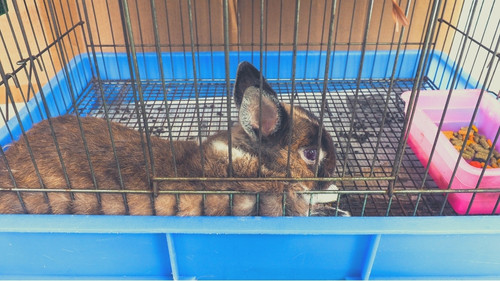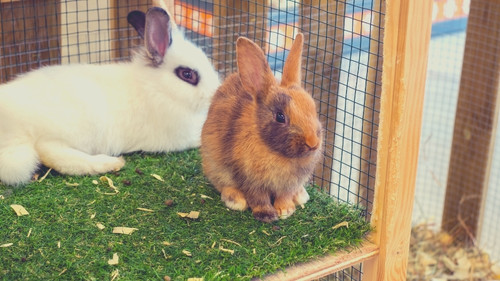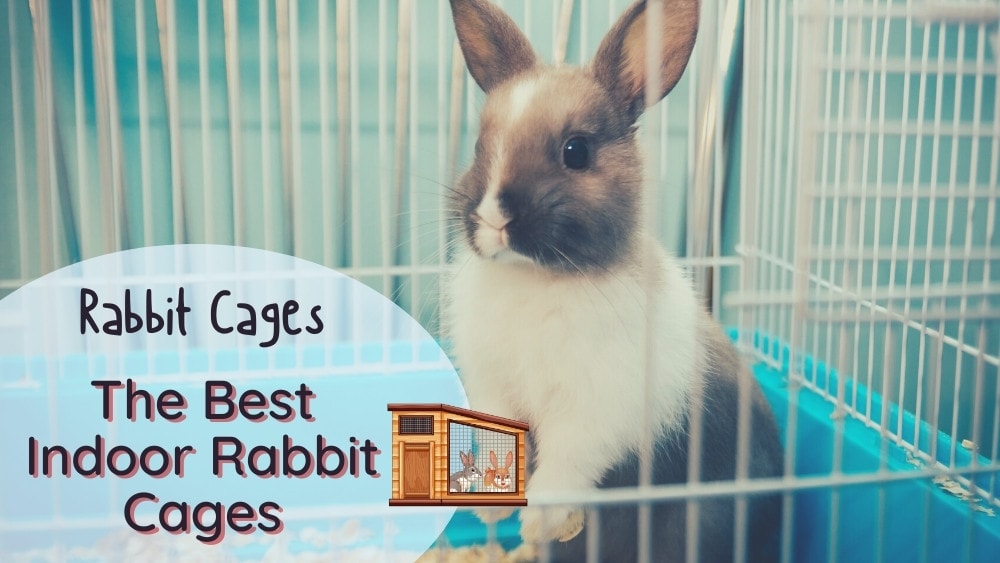You wouldn’t believe how hard it is to find a practical indoor rabbit cage. At least, not until you’ve shopped for one.
Many rabbit cages sold online look fancy, but they don’t hold up to the daily gnawing, scratching, and peeing of a real bunny.
So this article is not like every other “best indoor rabbit cages” review post. We’re not here to sell you pretty cages that don’t actually work.
We’re here to help you find a cage that meets your rabbit’s real needs, like his need for tidiness. His need for protection. His need for a safe and non-toxic environment. And his need to romp and jump and play and explore.
When picking our top rabbit cages, we’ve taken your needs into consideration as well. A rabbit cage should be easy to access, assemble, clean and move. It should contain the bunny mess while being pleasant to look at, not industrial.
Considering these factors, our overall favorite rabbit cage in 2023 is the Aivituvin Rabbit Hutch Indoor 62″ Rabbit Cage.
This indoor rabbit cage is roomy enough for 1 large rabbit or 2 medium or small breed bunnies. It securely holds your rabbit while having multiple doors and slide-out trays, so you can access every corner for cleaning. Aesthetically, it enhances your living room like a piece of bespoke furniture.
Aivituvin Rabbit Hutch Indoor 62″ Rabbit Cage: Best Overall

| Star Rating: | 4.5⭐ |
| Dimensions: | 62″L x 22.6″W x 33.5″H |
| Interior Floor Space: | 9.7 square feet |
| Materials: | Fir wood, paint, wire mesh, plastic. |
| Suitable for: | One large rabbit or two small ones. |
The Aivituvin Rabbit Hutch 62” Indoor Cage meets the needs of both bunny and owner. From a rabbit’s perspective, the cage has both open areas with good ventilation and an enclosed loft where your bunny can hide if it feels threatened. It has solid floors – not wire – which makes it a good choice for Mini Rex or other breeds that are prone to sore hocks.
With almost 10 square feet of interior floor space – not counting the upper level – this is one of the few rabbit homes available that provides plenty of room for a large breed rabbit, like a Champagne d’Argent. You can keep a bunny that weighs up to 10 pounds in this cage overnight or when you are gone for the day, as long as you let it out for exercise when you’re home.
The top of this cage opens, making it easier and safer to reach your bunny than cages with only side-opening doors. However, this cage also opens on the side, so you can clean every corner. The oversized drop trays help prevent bedding from spilling out of the cage, but when it inevitably does, the casters make it easy to move the cage and clean behind it.

What We Like
- Affordable for its size.
- Attractive design.
- The top-opening roof makes it easy to access your rabbit.
- Can be easily cleaned; no hard-to-reach corners.
- Comes with casters.
- Extra deep 3” drop tray.
What We Don’t Like
- Rabbits will chew on the wood.
- Wood can absorb urine.
- Will probably only last 3-5 years.
- Takes up quite a bit of space in your home.
- Too small for giant breeds.
- Requires assembly.
FXW HomePlus Playpen: Best for Giant Rabbits

| Star Rating: | 5.0⭐ |
| Dimensions: | Panels are each 24” high and 24.8” wide. Sold in sets of 6, 8, 12, and 16 panels so you can design a custom pen for your bunny. |
| Interior Floor Space: | 6-panel size is 8.5 square feet. 8-panel size is 16 square feet. |
| Materials: | Coated metal with silicone foot pads. |
| Suitable for: | All litter-trained rabbits, including giants. |
Surprise! One of the very best rabbit cages isn’t a cage at all! If your bunny is potty-trained to use a litter box, he will be happiest and healthiest living in an exercise pen rather than a small enclosed cage.
We love the FXW Indoor Playpen because it’s made from durable metal, but engineered to avoid any sharp edges that could scratch you, your rabbit, or your floor. The modular design means you can add extra panels and fashion them into whatever shape best fits your room layout. It’s quick to set up and folds for easy transport.
For small to medium rabbit breeds, you can use the 6-panel size. For large or giant breeds, use the 8 or 12-panel size.
When using the FXW Indoor Playpen as a rabbit home, you’ll need to position it on an absorbent floor mat and add a litter box and hiding holes. See our post on how to set up a rabbit’s enclosure for some awesome ideas on decking out your rabbit’s playpen with everything a bunny could need or want.

What We Like
- Great for free-range rabbits.
- Plenty of room for all breeds if you get the larger size.
- Easy to set up.
- Will last for decades.
- Lots of accessories available.
What We Don’t Like
- Takes up a lot of space in your home.
- Rabbits need to be litter trained to live in a playpen.
- Needs to be outfitted with a floor mat, litter box, and hiding space.
- May not provide as much protection from kids or household dogs as a cage.
Lovupet Rabbit Hutch Cage with Pull-Out Tray: Best Compact Rabbit Cage

| Star Rating: | 4.0⭐ |
| Dimensions: | 47.2″L x 19.6″W x 40.4″H (Each story has an interior height of 16.5”) |
| Interior Floor Space: | 7.5 square feet (counting both stories). |
| Materials: | Fir wood, galvanized steel wire, PVC tray |
| Suitable for: | Single dwarf breed rabbits. |
Honestly, the first two options on our list are far and away the best indoor rabbit cages. But if they are too large for your home, you can make use of vertical space and choose a double-story rabbit hutch.
The Lovupet Two-Story Hutch Cage is a good option for a small pet breed – like a Holland Lop, Netherland Dwarf, or Mini Rex – as long as you let your bunny out of its cage for a couple of hours of exercise every day.
My favorite thing about this cage is the way the entire top and front swings open, making it easy to access every part for cleaning. The PVC floor trays slide out for cleaning, but are shallow, so you will need to use a thin layer of bedding and clean them frequently.
There is room for a small litter box in the cage, so if your rabbit will use it, you may be able to avoid placing bedding in the cage at all. In this case, you can cover the floor with non-toxic non-slip mats and save a lot of time cleaning up.

What We Like
- Solid floors protect rabbits’ feet.
- Swing-open top and four opening front doors.
- Sturdy galvanized wire.
- Double-story design fits into apartments or small rooms.
What We Don’t Like
- Doesn’t come with casters.
- Requires assembly.
- PVC trays could be chewed and particles ingested.
- Wood elements of the cage will become worn and stained over time.
- Too small for two bonded rabbits or large breed rabbits.
- Not as long-lasting as other options.
PawHut Small Animal Playpen/Small Animal Cage: Best Hybrid Rabbit Cage

| Star Rating: | 4.5⭐ |
| Dimensions: | (Large size) 67″L x 46.5″W x 24.5″H |
| Interior Floor Space: | 21 square feet (including exercise pen.) |
| Materials: | Coated wire and plastic |
| Suitable for: | Single or two bonded small breed rabbits. |
While many rabbit owners may see the wire on this cage and assume it’s not a good option for bunnies, a closer look at the PawHut Small Animal Playpen and Cage reveals that it actually does meet a rabbit’s needs. This cage has wire sides but does not have a wire floor, so it won’t put your bunny at risk for sore hocks.
The wire and plastic construction is easier to clean than wood, and less likely to harbor bacteria and ammonia smells. The plastic bottom of this cage will be easy to wipe down as long as you clean it frequently and don’t allow urine to calcify on it. One of our favorite features is that the tray is several inches deep, which will keep the bedding from being kicked across your floor.
The cage component of this hybrid rabbit home is small; too small for a medium or large-breed rabbit. But you can keep one or two dwarf rabbits in this setup as long as they have access to the playpen most of the day. This cage comes in two sizes, but we would recommend the larger one no matter what breed of rabbit you have.
You will need to place a washable puppy pad under the playpen area of the cage to provide secure footing and protect your floors. You also may need to replace the ramp between the cage and the playpen; the ramp included with this cage is rather flimsy.

What We Like
- Lots of room for a single rabbit or pair of bonded bunnies.
- Solid floor with a deep litter pan.
- Wire and plastic can be more sanitary than wood.
- Cage keeps the rabbit secure when you are away.
What We Don’t Like
- Feels overpriced.
- Cage component is small.
- Exercise pen is lightweight; some users feel it’s flimsy.
- Included water bottle, food dish, and ramp are cheap quality.
Midwest Wabbitat Folding Rabbit Cage: Best for Travel

| Star Rating: | 4.0⭐ |
| Dimensions: | 37″L x 19″W x 20″H |
| Interior Floor Space: | 4.8 square feet |
| Materials: | Galvanized wire mesh, plastic drop pan. |
| Suitable for: | Traveling with small or medium rabbit breeds. |
At Fuzzy-Rabbit.com, we would never recommend a small all-wire cage like this as a rabbit’s full-time home. However, for travel, sometimes a wire cage is the safest and most practical solution for your bunny.
The Midwest Wabbitat Folding Rabbit Cage is not a carrying cage, but it’s easy to fold and pack along with you when you need to give your rabbit a secure place to stay overnight in a hotel or at a friend’s house. The slide-out drop tray will catch most of the mess, and the built-in urine guard will direct pee into the pan rather than the floor.
This indoor rabbit cage has 1×3” mesh on the sides and top and ½ x 1” wire mesh on the floor. This small-size mesh provides reasonably good support for rabbit feet and won’t cause sore hocks if you use it for just a couple of days at a time. You can place plastic resting mats over the wire for extra protection.
At 37″ long by 19” wide and 20” high, the larger size of the Midwest Wabbitat is big enough for any breed under 10 pounds as a short-term housing solution. There are doors in both its top and its side, but the doors are pretty small, and it might be difficult or even dangerous to pull your rabbit from this cage. A safer option is to open the cage door and wait for your bunny to approach you.

What We Like
- Folds and assembles without tools for easy transport.
- Wire and plastic construction is easy to sanitize.
- Chew-proof design: rabbits can’t escape.
- Can be placed inside an exercise pen for extra play space.
What We Don’t Like
- Plastic tray is too flimsy for long-term use.
- Wire floor can cause pododermatitis (sore hocks) if used regularly or for rex-furred breeds.
- Does not include any dark, covered hiding areas.
- Too small for full-time housing without using an exercise pen also.
How To Choose the Best Indoor Rabbit Cage
Are Cages Good or Bad for Rabbits?
Are cages bad for rabbits? Despite what many vehement voices on the internet say, the answer isn’t a straight yes or no.
When we talk about rabbit housing, we like to differentiate between a “cage” and an “enclosure.” A “cage” usually means a small wire and/or wood box designed to confine a rabbit. An enclosure is a safe but roomy space that a rabbit can consider its home.
All rabbits need an enclosure. An enclosure can be an exercise pen outfitted with a litter box and hiding/climbing structures, or it can be a cage of sufficient size, made of safe materials. Even if your rabbit ranges freely in your home, it should have an enclosure where it can come and go as it pleases.
An enclosure gives a rabbit a sense of security. It becomes a personal space where bunnies can hide from real or perceived threats in their environment. The enclosure keeps a rabbit safe when you have visitors with small children, or when you will be away for a while and need a place to keep Bunny out of trouble. In this sense, cages are good for rabbits.
Cages are bad for rabbits when they become prisons. A rabbit should never live 24/7 in a two-foot-square box with no chance for exercise, stimulation, or interaction with other rabbits.
Cages are also bad for rabbits when they are made of unsafe materials. Bad materials for rabbit cages include poultry netting (dogs can rip through it), galvanized wire with widely-spaced mesh (rabbits can catch and break their legs in it), or pressure-treated lumber (contains harmful chemicals.)

What is the Best Type of Rabbit Cage?
There are many types of rabbit cages. Here are some pros and cons of each:
- All-wood rabbit cages. All-wood cages are typically DIY solutions for outdoor rabbit keeping. They are insulating and protect against predators, but they also absorb urine, are hard to clean, and don’t provide enough ventilation.
- Combination wood and wire cages. If made of high-quality wood strategically placed in areas where the rabbit can’t chew it, a combination wood/wire cage works well for indoor bunnies. It’s also the most visually attractive option.
- Wire cages with plastic bottoms. While too small to be a rabbit’s full-time residence, these cages are easy to clean and can be a rabbit’s “safe space.” They work well if you place them inside an exercise pen and leave the door to the cage open. The PawHut Hybrid Cage is a great example.
- All-wire cages. All wire cages are the most sanitary because the rabbit’s droppings fall to the tray below the cage. Advocates for wire cages claim this protects rabbits from coccidiosis and poopy bums. However, pet rabbits can stay just as clean if they learn to use a litter box. Most wire cages are too small for rabbits and can damage their footpads.
- Exercise pen enclosures. These days many pet rabbit owners skip the cage and opt for an exercise pen enclosure like the FWX HomePlus Playpen. These are roomy and can be highly customized to your lifestyle and your bunny’s preferences. The only downside is that a rabbit needs to be litter trained to avoid making a huge mess in the pen.

Do Rabbits Like Multi-Level Cages?
No, a multi-level cage isn’t attractive to most rabbits. Bunnies are ground-dwelling creatures and would rather burrow into the earth than climb. While rabbits may use the upper level of a two-story cage, it doesn’t usually become a favorite hangout.
How Big Should a Rabbit Cage Be?
Rabbits need room to roam. A good rule of thumb is a rabbit needs one square foot of floor space per pound of body weight. Since rabbits don’t like being up high, most experts say you shouldn’t include the floor space of upper levels of rabbit cages in your calculations.
This means that a 4-pound Holland Lop rabbit needs a 24” x 24” cage as its home base, with daily access to an exercise pen. A 16-pound Flemish Giant should live in a pen that’s about four feet square.
Rabbit cages should be at least 18” high, or tall enough that a rabbit can comfortably stand on its hind legs.
Can Two Rabbits Live Together in a Cage?
Yes, if two rabbits are spayed or neutered and bonded, they can live together in a large cage. The cage must be large enough that each bunny can claim its own corner, and has a place to play by itself when it needs a break.

Rabbits living together in a cage that’s too small is a recipe for fighting, dominance displays like humping or growling, and destructive behaviors like fur chewing.
Besides Size, What Features Should You Look For in a Rabbit Cage?
- Security. The cage should be escape-proof and strong enough to keep children, cats, dogs, and ferrets or other pets out. The latch must be secure but easy to operate in case you need to grab your bunny in an emergency.
- Good ventilation. Rabbits are susceptible to respiratory diseases like Snuffles if they don’t get frequent air changes.
- Easy to clean. Look for areas of a cage that would collect droppings or urine. Are they easy to reach for cleaning? Are they made of washable material?
- Easy to move. You will frequently need to sweep up bedding around your rabbit’s cage.
- Top-opening. When you need to remove your bunny from the cage, it’s safest to lift him out from the top.
Important! Never drag a rabbit out of its cage. This can cause broken toes or toenails, and terrify your bunny.
Can You Make Your Own Indoor Rabbit Cage?
You can certainly DIY a rabbit enclosure, but you may find it’s not more affordable than purchasing a ready-made one. If you choose to use an exercise pen enclosure instead of a rabbit cage, you can customize it with grass mats, castles, climbing structures, tunnels, digging boxes, and all sorts of fun add-ons.

If you decide to build your own rabbit cage, make sure to use safe materials. Hardware store lumber doesn’t cut it; I’ve seen rabbits chew through a 2×4” in less than a month. If you use wire, avoid chicken netting and opt for 14 or 16-gauge GAW (galvanized after welded) mesh instead.
Final Thoughts
A high-quality rabbit cage mimics a rabbit’s natural habitat by offering both small enclosed spaces and room to race, play, and binky-jump. It should keep the bunny away from its waste, and be easy to clean and sanitize. The Aivituvin Rabbit Hutch 62” Indoor Cage checks all of these boxes, making it the best indoor rabbit cage on the 2023 market.

Did you pick a cage or playpen enclosure for your house rabbit? Please share your best rabbit setup ideas with us in the comments!


